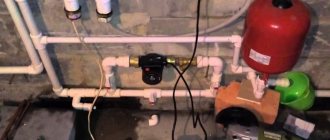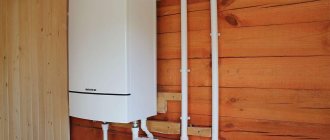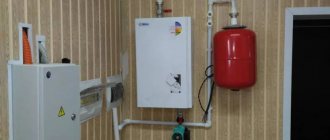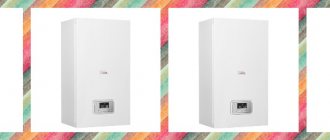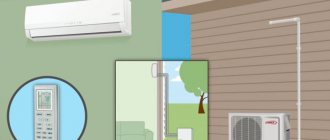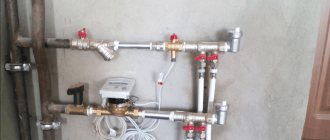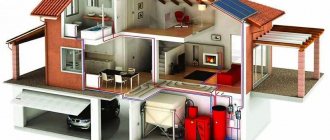The idea of heating a house with electricity looks attractive, because it is the most comfortable type of heating. But the cost of energy is cause for concern. Therefore, the homeowner wants to assess in advance what costs the electric boiler will incur - whether it is profitable or not to use this device, and what difficulties there may be.
Features of heating a house with electricity
If you do not take into account operating costs, the choice in favor of such a heating system can only be characterized positively:
- No chimney required.
- There is no risk of fire (provided the connection rules are followed), explosion and gas poisoning.
- No design or permission from government agencies is needed.
- Full automation. Unlike the gas analogue, it is safe to start the device in the absence of occupants for a long time.
- The heating output is regulated within a wide range without reducing efficiency.
- The boiler is inexpensive.
But there are also negative points:
- High electricity costs.
- Low reliability. The overhead power grid is the most vulnerable part of the infrastructure.
After storms and hurricanes, populated areas are the first to remain without electricity. Therefore, it is risky to make do with an electric boiler alone; it is recommended to additionally connect at least a low-power solid fuel device to the heating system as a backup. The list of units is on the website.
Device
The donor environment of the system is usually:
- The soil is below the freezing level. Away from the upper layers, the temperature of the earth is mostly stable (within +10-14 degrees).
- Non-freezing reservoir or groundwater. They are pumped out from the well with a good supply. After heat transfer, the water is directed to the drainage.
- Air outside. The minimum air temperature is limited by the characteristics of the refrigerants used. The optimal temperature level for the operation of air heat pumps is no less than -25 degrees. As this value decreases, the efficiency of the pump will also decrease.
As a result, to obtain 1 kilowatt of heat, 2.5-7 less energy is required than to obtain a kilowatt of electricity. To some extent, this is influenced by the characteristics of the device and the temperature of the heated home. The disadvantages of this heating method include the high cost of equipment.
What you need to know before installing heating
The power of the line supplied from the power transmission line is limited. According to Decree No. 334 of the Government of the Russian Federation, which came into force in April 2009, energy networks are required to allocate 15 kW per household. At first glance, this is a lot: on average, an electric boiler of this power can heat a house with an area of up to 150 square meters. m.
But there are other energy-intensive receivers in the home and on the property: a boiler, washing machine and dishwasher, oven, microwave, equipment in the workshop, etc. It is necessary to assess the level of consumption and calculate how much is left for heating.
If you apply to Rostekhnadzor, the limit may be raised. But in some regions the state of the networks does not allow this. There is a solution, but it can be expensive: sometimes a homeowner has to pay to replace a transformer at a substation in order to connect a powerful heater.
Heating system installation
It is possible to positively resolve the problem - how to install heating in a private house (the diagram is given above) if you follow certain rules and the sequence of work. Installation work begins with the installation and subsequent piping of the boiler. Gas boilers with a power of up to 60 kW are installed in the kitchen. All rules for installing boilers are described in detail in the instructions for them.
Piping a heating boiler is the process of connecting the necessary equipment.
There are two ways to install a heating circuit from gas and water (metal) pipes - welding and using threaded connections. Of course, you can quickly create a system using the welding method, but it will turn out to be non-separable. By connecting the system pipes with threaded connections, you can easily change the configuration or replace any section of the pipeline at any time. For any installation method, the connection diagram for heating radiators in a private house requires special attention, and it must be drawn and calculated in advance.
Example of electricity consumption
For clarity, you can consider the organization of heating in a house with an area of 90 square meters. m, located in the Moscow region. There are electrical appliances with the following power consumption:
- water heater and washing machine: 1.5 kW each;
- 2 socket groups with 10 A circuit breakers, i.e. designed for a power of 220 × 10 = 2.2 kW each;
- internal and external lighting, supply and exhaust ventilation system with recuperator: total 1 kW.
The kitchen stove runs on bottled gas.
The total power consumption is 8.4 kW. 15 – 8.4 = 6.6 kW remains for heating.
The required rated power of the boiler corresponds to heat loss in the coldest week of the year + a reserve of 20%. To calculate them, a complex calculation is required, but a less accurate simplified version can be applied to a standard house: Q = S × K, where
Q – heat loss in the coldest week, W;
S – heated area, sq. m;
K – specific heat loss, W/sq. m.
Depending on the region, K is taken equal to a fixed value:
- southern regions: 60-80;
- central part of the country: 90-110;
- northern districts: 120-200.
According to the condition, the house is located in the Moscow region, we can assume that K = 100 W/sq. m.
Taking into account a reserve of 20%, the power of the heat generator in the coldest week will be:
W = 90 × 100 × 1.2 = 10,800 W = 10.8 kW.
Conclusion: to help the 6.6 kW electric boiler, it is necessary to install a solid fuel boiler - 4.2 kW. Or one combined one, running on wood and coal, but with heating elements in the heat exchanger.
We heat with gas
Gas heating can rightly be considered more profitable if the gas pipe is located in close proximity to the house. To save on connecting to the highway, it is recommended to use the following rules:
- All services must be ordered in one place. This includes design, installation and subsequent service;
- It is necessary to properly prepare the place for the boiler;
- The boiler itself must correspond to the area of the house;
- You should choose the optimal size of the chimney.
The main advantage of gas heating is the low cost of energy. However, in essence, all the advantages end there.
Which electric boilers are most often used to heat a private home?
There are 4 varieties:
- heating elements;
- electrode;
- induction;
- heat pumps.
The first ones are the most common. Their advantages:
- affordable price;
- low requirements for the coolant: it only needs to be desalted once before the first use;
- simple and inexpensive repairs;
- soft start (prevents power surges in the network).
Electrode boilers are cheaper than heating elements and are simpler in design. But the user has to prepare the coolant according to the recipe. At the same time, its chemical composition is constantly changing, so every 1.5 months it is necessary to pour new liquid into the circuit. This makes operation difficult.
Induction boilers, on the contrary, are able to work with any coolant, but their price is 4 times higher than that of heating elements.
Both of the latter types have a common drawback: their design does not provide for a soft start, so when switched on, voltage surges occur in the network.
If funds allow, it is advisable to purchase a boiler that operates on the principle of a heat pump. It is beneficial to use it. For every kilowatt of electricity consumed, the device produces up to 5 kW of heat. But the system will require a lot of money: in addition to purchasing an expensive device, you will have to pay for the construction of an extensive external heat exchanger (a long circuit of pipes in the ground).
Warm floor
Underfloor heating refers to a heating system where, instead of standard radiators, heat is radiated from the floor surface.
For this purpose, the following design solutions can be used:
- A system of thin pipes with coolant. Placed under a screed or on a special heat distribution platform under the finishing coating.
- Heating cable. It can be mounted both in the screed layer and in the thickness of the tile adhesive under the tiles.
- Film heater. A dense dielectric sheet of polymer is used as a heating element. It has two copper current-carrying wires connected to each other by current-carrying elements with high electrical resistance. The place where film heated floors are laid is usually the last layer under the finishing floor covering with high thermal conductivity. Usually this is linoleum, laminate or parquet board.
The inertia of a film laid under a final coating is an order of magnitude less than that of a cable under a tile or screed. The time required for the film heater to bring the floor covering to a comfortable +25 degrees is no more than 5-10 minutes. At the same time, a cable under a tile does this in 30 minutes, and a cable in a screed does it in 3-5 hours.
Installation of the heating film is so simple that the procedure for installing this electric heating with your own hands usually does not cause difficulties:
- Laying the substrate. For these purposes, a special material is used - penofol (foamed foil insulation). It needs to be laid out on a rough base with the foil facing up.
- Connection with thermostat and network. It is necessary to crimp the terminals on the current-carrying conductors and on the wire. Bitumen overlays are used as insulation. A thermal sensor is installed under the surface of the film.
- Finishing. Suitable options for finishing material on top of the film heater are laminate, linoleum or parquet.
It is recommended to consider the following tips on how to make electric heating with your own hands:
- One thermostat can withstand a load of no more than 3.6 kW. It is advisable to equip large premises with several separate power circuits with autonomous thermostats.
- It is prohibited to apply heating film to areas of the floor under furniture and other objects adjacent to the floor. Like other electrical appliances, the film does not tolerate overheating.
Electricity costs for heating a house
The boiler reaches its rated power mode only during the coldest five-day period of the year. The rest of the time it operates with reduced heating output. On average it is:
- in the winter months (December, January and February): 50% of nominal;
- in November and March: 30%;
- in October and April: 15%.
For example, a 10 kW electric boiler will consume:
- During the winter months: 10 × 0.5 × 24 hours × 90 days = 10,800 kWh.
- For November and March: 10 × 0.3 × 24 × 61 = 4,392 kWh.
- For October and April: 10 × 0.15 × 24 × 61 = 2,196 kWh.
Total: 10,800 + 4,392 + 2,196 = 17,388 kWh.
In 2022, in the Moscow region, the tariff for houses with electric stoves and heating corresponds to 3.89 rubles/kWh. This means that the costs for the season will be 17,388 × 3.89 = 67,639.32 rubles.
Accordingly, if we talk about an electric boiler for heating a house of 200 square meters, the amounts will be much higher.
Introduction to the boiler piping of a heat accumulator
A heat accumulator is added to the small circuit with forced water circulation, connecting it with an electric boiler. A heat accumulator is a tank covered with external thermal insulation with a capacity of up to 3000 liters. Thanks to a large circuit that spans the entire house, the container is connected to the heating devices. A prerequisite is the presence of coolant recirculation inside the tank: this allows you to maintain a constant temperature in the batteries, regardless of the level of heating of the water in the battery.
What affects electricity consumption
All boilers convert the energy used into heat in a 1:1 ratio. With 100% efficiency, negligible losses in wires and connections are neglected. The exception is heat pumps, but they are still rarely used.
Thus, there are only 2 ways to reduce electricity consumption:
- Reduce heat loss. To do this, the home is covered with mineral wool or polystyrene foam, and the cracks are sealed.
- Optimize the operation of the boiler in order to eliminate excessive consumption of energy resources.
The second problem is also solved in 2 ways:
- Using weather-sensitive automation. Such a system promptly warns the boiler about the onset of warming, and it manages to reduce power without overheating the room.
- Programming. A model with this function, according to user settings, reduces heating output when residents are at work or sleeping. The rest of the time the device returns to normal mode.
For inexpensive heaters, the first option is not suitable. They do not have the function of connecting weather-compensated automation. Then it is recommended to install at least a remote thermostat: it maintains the room temperature at a given level.
It is possible, without reducing consumption, to reduce financial costs. They are switching to differentiated metering of electricity consumption with a big discount at night (RUB 1.68 instead of RUB 3.89). The heating system is equipped with a heat accumulator - a large capacity in which the boiler raises the temperature of the working environment to +98˚C within a grace period. During the day, boiling water is gradually supplied from it through the mixing unit into the circuit as needed; the heater does not work at this time.
In this case, you will have to pay 17,388 × 1.68 = 29,212 rubles for the season. But there is a nuance: the rated power of the boiler should be twice the design power, because at night it works both for heating and for “charging” the heat accumulator. For the example given, a 20 kW unit will be required.
Scheme 3: infrared heating
Device
Any heating device gives off heat to surrounding objects in two ways:
- Due to convection (that is, direct contact with air and the transfer of thermal energy by its flows);
- Due to thermal radiation . Any person who has at least once sat by a winter fire is familiar with its effect: the air is cold, but your hands and face feel warm.
By changing the temperature and surface area of the device, one of the heat transfer methods can be achieved. A source of thermal energy with a small area and a relatively high temperature will heat the room mainly with infrared rays, and a moderately warm battery with developed fins of sections will heat the room with convection.
Infrared electric heating of a private home can be organized using several types of devices:
| Image | A type of infrared heater |
| With quartz tube . It contains a heating coil that heats up to 600-800 °C when power is applied. | |
| With ceramic or glass heating panel . Its temperature is much lower - 80-90 degrees. | |
| With metal panel (aluminum or steel). Behind the decorative screen there is a low-temperature heating coil in a ceramic insulator. | |
| Film. The already familiar heating film for underfloor heating or a thin polymer sheet with a carbon fiber fused into it can be used as a heat source. |
How to organize infrared heating at home with your own hands? Here are some simple rules for installing IR heaters:
Optimal placement : on the ceiling, so that the thermal radiation is directed downwards.
It is better to place the IR heater under the ceiling. Then it will warm the bottom of the room.
Connection : to a regular outlet or 220 volt wiring through blocks.
Restrictions:
- The load on one outlet should not be more than 3.5 kW;
- The cross-section of copper wiring should not be less than 1 mm2 per 10 amperes peak current.
Principle of operation
When IR radiation sources are located under the ceiling and heat the floor, the temperature distribution in the room becomes the same as when using a heated floor: warm below, cool above.
Infrared heating with a ceiling device: temperature distribution is the same as with underfloor heating.
But that's not all. Thermal radiation warms not only the floor and furniture: the skin and clothes of the people in the room also feel warm. As a result, the comfortable temperature zone decreases from 22-24 to 14-16 degrees.
The cost of installing a heating system is an order of magnitude lower than in the case of a heated floor: a device with a power of 1 kW and costing 1,500 rubles is capable of heating an area of 15-20 m2. For comparison, an inexpensive film heater of the same area with a simple mechanical thermostat will cost at least 12-15 thousand.
Benefit : at an outside temperature of 0 ° C, reducing the average temperature in the room from 25 to 15 degrees will provide energy savings of 40%.
Disadvantages : the entire living area of the house must fall within the radiation zone of IR heaters. Outside this zone it will simply be cold.
In a room with infrared heating, you will only be warm in the area of the heater.
Other heat sources
To estimate how much an electric heating boiler consumes per month, you need to compare it with other energy sources. It should be taken into account that the efficiency of fuel boilers does not reach a hundred: for gas boilers it is about 93%, for wood and coal boilers it is about 85%.
Below is the cost per 1 kWh for different types of fuel:
- Natural gas: 0.68 rubles, taking into account efficiency – 0.75 rubles.
- Oak firewood: 1.09 and 1.36 rubles, respectively.
- Coal: 1.33 and 1.57 rubles.
- Wood pellets: 1.51 and 1.78 rubles.
- Liquefied gas: 1.99 and 2.13 rubles.
- Diesel fuel: 3.51 and 3.90 rubles.
In each case, heating costs for the season will be (for 17,388 kWh):
- natural gas: RUB 13,041;
- oak firewood: RUB 23,648;
- coal: RUB 27,300;
- wood pellets: RUB 30,950;
- liquefied gas: RUB 37,036;
- diesel fuel: RUB 67,813.
The average price level is given.
In cases where it is not possible to use a solid fuel or gas unit, installing an electric boiler for heating a private home is a good option.
Equipment options
To organize heating you can use:
- Oil and liquid-free electric radiators. They are distinguished by high safety and efficiency indicators.
- Cable and film heating systems in floor coverings. The popularity of underfloor heating has been increasing recently. Different types of heating cables are used to heat the floor. They can be installed directly into a concrete screed or under the floor covering. Installing a heated floor requires theoretical knowledge and work experience. Thin film, mat or heating cable systems differ in installation and connection.
Before installing the heated floor, reliable thermal insulation of the base is done. In each room where underfloor heating is installed, a thermostat is installed to regulate the operation of the electric heating system. Such floors are installed in all rooms or selectively. Most installations are carried out in bathrooms, toilets or kitchens.
Wall convectors are dry and liquid. Dry convectors immediately convert electrical energy into heat. Their main advantage is that they can be turned off for a long time without the threat of defrosting. There are no particular difficulties with the installation of convectors. For each installed convector there is a grounded power socket with a circuit breaker installed in the electrical panel. Liquid convectors are filled with non-freezing liquid or water. After switching off, such a convector still gives off heat to the room for some time.
Infrared heaters heat nearby objects and the floor, and they warm up the air. Their use makes it possible to separately regulate the set temperature in each room. If you have five rooms in your house, you will need five infrared heaters, automatic machines, thermostats and an electrical cable. One of the advantages of this home heating system is the saving of usable space.
Water electric heating has found its wide application for heating private houses. It differs from a gas system or a stove with a water circuit by installing an electric boiler. If the house already has water heating installed, an electric boiler can be installed instead of or in parallel with the old boiler. The disadvantage of such a system is the use of a water circuit.
These systems are used to constantly heat the building. To temporarily heat a house with electricity, use an electric fireplace or fan heater.
Conclusion
Heating with electricity is unprofitable - only diesel fuel is more expensive. But if it is possible to implement a scheme with a heat accumulator, the energy resource's costs will reach the level of coal and will be comparable to natural gas (the difference will be 25%). This makes sense, especially when you consider the many benefits of electric heating. In any case, each user decides for himself whether to install an electric boiler or convectors as an alternative.
Disadvantages of work
The main disadvantage of electric heating is the high energy consumption. In some areas, energy prices are quite high, so this method may simply not be profitable.
The third disadvantage can be considered the unstable voltage in the power grid, especially in rural areas. Purchasing your own generator eliminates this problem, but significantly increases financial costs.
Have you decided to heat your house with electricity? It is necessary to take into account the condition and power of the electrical wiring. For a large private house, a three-phase power supply may be needed. You will need to find out exactly how much power is allocated to the house and what part of the allocated power can be used for heating.
Electric heaters
*
Modern electric heaters, which are used to heat a home, can do an excellent job of heating a country house. Thanks to the ability to customize the thermostat, you can maintain the desired temperature even if no one lives in the dacha.
Attention: Since some models of electric heaters are equipped with a timer, it is possible to set the desired time for turning them on and off. Modern devices can even be controlled by sending SMS messages. They can be used to both turn the device on and off.
To make your choice easier, you should consider the most popular types of electrical appliances used for heating country houses and find out their advantages and disadvantages.
Oil radiators
*
Oil radiators have been used for heating for a long time. They have fully proven their effectiveness. Inside their body there is oil, heated by a heating element. The surface of the radiator heats up and transfers heat. Some models of oil radiators are equipped with fans. Thanks to them, heat transfer can be accelerated.
But these heating devices have some disadvantages, the main one being their heavy weight. In addition, radiator models equipped with fans are more expensive. Their disadvantages include strong heating of the surface. After all, careless touching can result in a burn.
